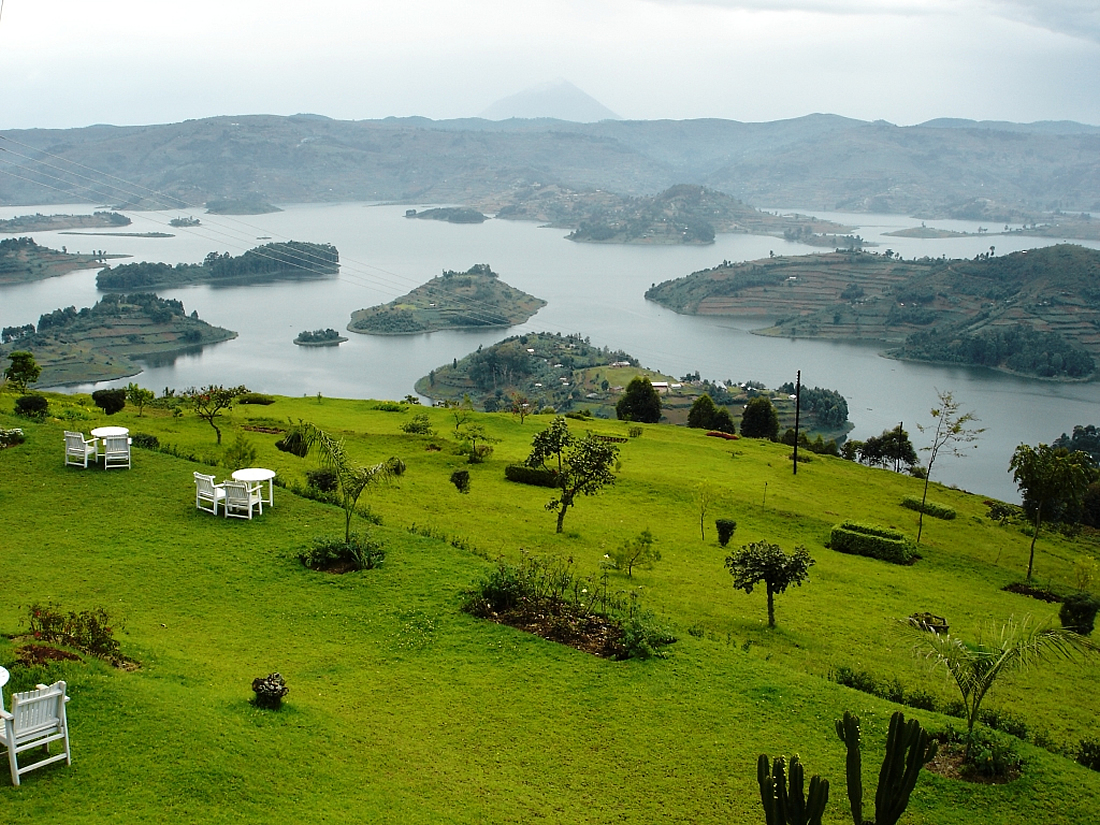Lake Bunyonyi ought to be considered one of the natural wonders of the world and, now that I’ve seen it before my own eyes, it’s joined the ranks of my most beloved travel destinations.
 Believed to be the second deepest lake in Africa, Lake Bunyonyi is a body of water in southwestern Uganda near the Rwandan border, and one of the country’s top natural treasures. And, at 1,962m above sea level, the lake enjoys moderate temperatures year round, cool in both the mornings and evenings. Most visitors make it an R&R stop after gorilla trekking in nearby Bwindi Impenetrable Forest, or a wildlife safari in Queen Elizabeth National Park even can proceed to Kibale National Park to trek chimpanzees.
Believed to be the second deepest lake in Africa, Lake Bunyonyi is a body of water in southwestern Uganda near the Rwandan border, and one of the country’s top natural treasures. And, at 1,962m above sea level, the lake enjoys moderate temperatures year round, cool in both the mornings and evenings. Most visitors make it an R&R stop after gorilla trekking in nearby Bwindi Impenetrable Forest, or a wildlife safari in Queen Elizabeth National Park even can proceed to Kibale National Park to trek chimpanzees.
Lake Bunyonyi is framed by lush, green-terraced hills that reach a height of 2,200-2,478m, but it’s the 29 islands of various shapes and sizes scattered across the water that make it most magical — we could’ve admired them all day. It’s a sight that reinvents itself every hour or two with the ever-changing climate and direction of the sun. In the early morning, the islands weave through cotton candy-like streams of mist and, in the afternoon, they’re bathed in the warm glow of the sun. Later, they’re silhouetted against a dim sky as evening approaches. One day the islands vanished from sight completely, hidden under a blanket of clouds, but it only took an hour to see them emerge once more.
There’s nothing like that powerful moment when the mystical scene opened up to us for the first time after arriving at Arcadia Lodge, a cottage high up on a hill that claims to have the most breathtaking panorama of Lake Bunyonyi. If you don’t stay as a guest, be sure to at least visit for a drink or meal on the terrace to enjoy the view. So overwhelmed Jill was by the lake’s sheer beauty that I found her in tearful meditation, silently absorbing what was before her eyes. What fantasy did we step into to find such natural splendour?
Things to Do at Lake Bunyonyi
Apart from worshiping the scenic landscapes from a hilltop, there’s plenty to do here, so I recommend spending at least a night or two on its shores or one of the islands.
Swimming: Lake Bunyonyi is known as one of the few lakes in Uganda free of bilharzia, making its waters safe for swimming. I didn’t find the weather warm enough so refrained from taking a dip. It’s also free of dangerous wildlife like hippos and crocodiles. The only warning for visitors is the depth — inexperienced swimmers should take caution.
Ride a Canoe: The most common mode of transportation on these waters is the dugout canoe, which offers a completely different perspective of the lake. You can rent your own to explore the islands or select a guided tour.
Each island is associated with a legend. Punishment (Akampene) Island, the smallest and most notorious of the 29 islets, holds a dark reputation: it’s where pregnant, unmarried girls were exiled to starve or drown if they attempted to swim away.
One of the excursions sold to tourists is a visit to a Batwa tribe of pygmies. The Batwa in this region, one of the original inhabitants of the country, were dispossessed of their ancestral lands by the government to build the Echuya Forest Reserve with tragic consequences. To survive, they invite tourists to their community, where they perform song and dance.
Hiking and Nature Walks: Hire a local guide to lead you along the best hiking trails on the islands or through the terraces of the Kigezi highlands to be rewarded with spectacular views of the landscapes and even some wildlife. Forest and tree plantations can be found on some of the islands, as well as monkeys and zebras. Otters can also be spotted in the waters.
Birdwatching: Meaning “the place of little birds”, Lake Bunyonyi takes its name from the abundant birdlife that call it home. Over 200 species are found here, including herons, weaver birds and grey-crowned cranes.
How to Get to Lake Bunyonyi
To reach Lake Bunyonyi independently, you first have to make your way to the town of Kabale, about an eight-hour bus ride from Kampala. From Kabale, the lake is 20-25 minutes by taxi. Given its proximity to Rwanda, you may want to consider accessing the lake from Kigali (or vice versa), which is only 1.5-2 hours by car. If you need to purchase your visa at the border, however, add another 30 minutes to one hour to your journey (weekdays are busier).

